Nobody who returns from Porto can speak of it without gushing. Stunning geography combines with rich history, culture, and cuisine—and all with the cheapest prices in Western Europe.
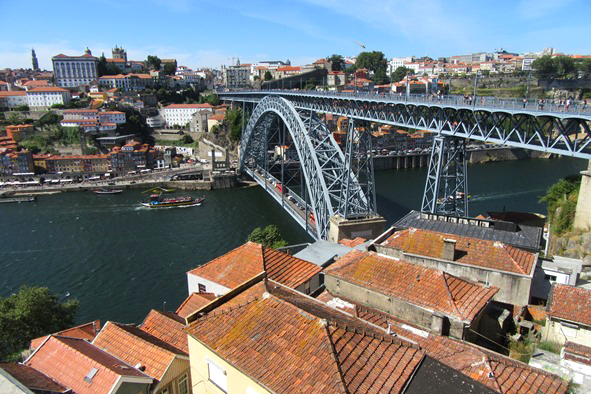
Dom Luís I Bridge in Porto from Gaia side (Photo: Mike Dunphy)
A funny feeling came over me as a cab driver deposited me on the Gaia side of the Dom Luís I Bridge in Porto, Portugal’s second city. A confusion over the route and price led me to accidently overpay the driver. Looking at the euros I had just placed in his hand, the driver looked at me strangely, then handed five back to me, pointing out my error and adding, “It wouldn’t be right of me to take all ten.”
With multiple shakedowns by cabbies in New York, Prague and Istanbul lodged in my memory – including one who simply hit the gas after I got out of the car and handed him a large bill through the window to change – such honesty seemed almost miraculous. I took it as a sign of good things to come.
The next mind-blower was a mere 100 yards away at the center of the metal arched span of the bridge. Below, the Douro River cinematically splits Porto into its two major components in much the same way the Bosphorus does to Istanbul. Terracotta-roofed buildings climbed the sloping the banks, while on the flatter parts, fishing and touring boats bobbed in the glistening water. In the air a subtle Middle Eastern and African spice remains, imprinted in Porto’s DNA during 157 years of Moorish occupation. You can hear it in the twang of the guitars, see it in the weave of the carpets, and taste it in the exotic flavors of the cuisine.
One of Porto’s top tourist spots, Ribeira, is also visible on the shore from the bridge, with its brightly painted facades standing out from the surrounding neighborhoods. A UNESCO-designated world heritage site and feature of many Porto postcards, it was my main goal of the morning, and I hoped to arrive earlier than the thick crowds of tourists.
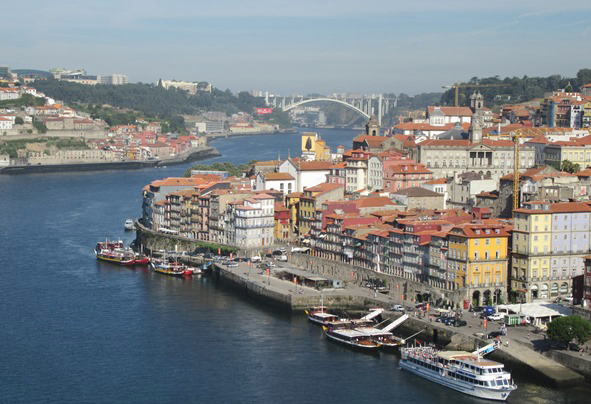
Crossing the Dom Luís I Bridge in Porto (Photo: Mike Dunphy)
Sé do Porto
The road off the bridge runs first past Sé do Porto, the Romanesque cathedral that has stood in some form or another since the 12th century. Considering the rich history, it’s remarkably spare in ornamentation as cathedrals go in Portugal, much like the broad square outside. However, the view over the city enlivens the spirit, or at least the romance, as evidenced by at least one couple snuggling away in the corner and my own rising heartbeat, which only increased as I plunged into the narrow sloping streets below, loosely aiming for Ribiera.
Poking my nose around every curious angle of the tight, bending lanes, I spied a Christian shrine cut into the corner of a building that depicted two women—the first seemingly passing a baby to the second—sitting on a throne of cherubs and fresh flowers. While attempting to decipher the meaning, a rough looking man, possibly drunk, wobbled over to me in haste. With no one else in sight, I stiffened for confrontation, or at least an uncomfortable bout of begging.
Instead, he merely directed a trembling finger to the shrine, and in a twitchy voice said, “Santa Ana,” And then, almost as quickly as he arrived, disappeared with a smile and a “Bom Dia,” leaving me with a heavy sense of Christian guilt, soon replaced by the warmth of the man’s selfless good intentions, much like the cab driver. That funny feeling now became distinguishable: I was falling in love with Porto.
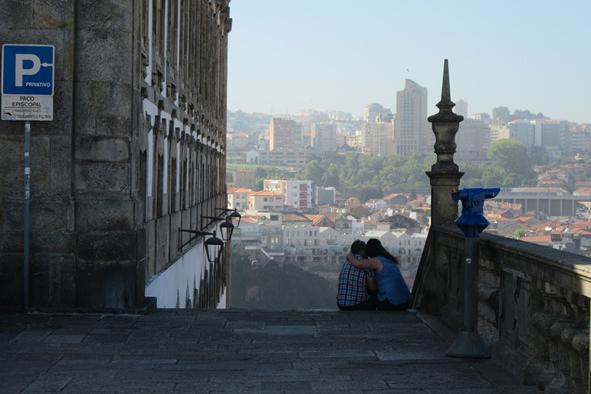
Looking out over Porto from Sé do Porto Square (Photo: Mike Dunphy)
The Ribeira
The rest of the morning only intensified the infatuation, starting with the Ribeira, where I arrived around 9:30am to find the shopkeepers and restaurant staff extending awnings, opening windows, and dragging out tables with a certainty of rhythm brought on by routine and a culture steeped in music. Even the man in charge of the public toilets sang, as if oblivious to the putrid odors swirling around his mop. But the real color came from the gold, aquamarine, and ruby tiled buildings dappled by the reflective glitter of the passing Douro River.
Although Porto can’t compare in tourism numbers to cities like Paris, Venice, and Barcelona, the crowds are still great enough to make accessing the most popular sights a significant challenge by late morning. With Ribeira beginning to fill, I ducked quickly into the baroque and gothic Church of Saint Francis, then made a beeline for the Clérigos Tower, which you can climb for one of the best views of the city. Unfortunately it was two-hour wait. The rules required staying on the premises (ideally in the gift shop) the entire time.
A block away at Livraria Lello, one of the most beautiful bookshops in the world, it was even worse, with one line all the way down the block just to get tickets, and a second line down the opposite side of the street to actually enter.
Thankfully, such clots are few and far between in Porto. A wander around the surrounding neighborhoods – particularly the arts district along the Rua de Miguel Bombarda – proved memorable and refreshingly free of competition.
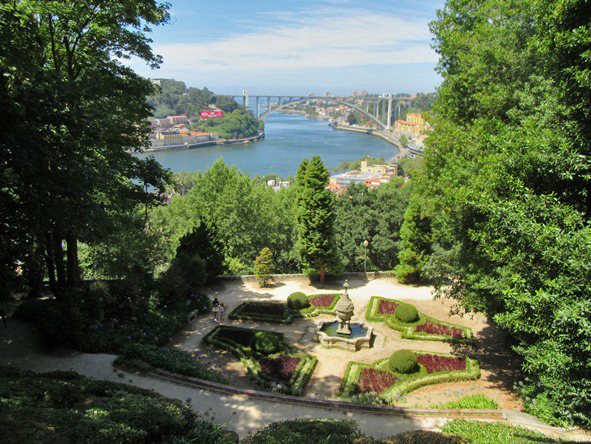
Crystal Palace Gardens (Photo: Mike Dunphy)
Crystal Palace Gardens
Where the street ended, Crystal Palace Gardens began, embracing more than eight acres of sculpted and terraced parkland. Just inside the entrance, five big blue letters spell out Porto, while tourists scramble for photos in front, on top, inside, and below. However, this commotion largely dissipates after rounding the domed pavilion. Here, French-style gardens step elegantly down the hillsides overlooking the Douro River, with secluded spots along the way, where couples actively embrace the romance. Indeed, if anyone got on their knees and proposed marriage, it wouldn’t be out of place. I was sorely tempted at this point to tear up my plane ticket and stay in Porto till death do I part.
My stomach brought me back to reality with a mighty rumble, and I promised it a feast for the ages if it would hold off until reaching the Mercado do Bolhão, which had been recommended by several locals as one of the best lunch spots in the city – and a cheap one.
They did not lie. The somewhat ramshackle quasi-restaurants, squeezed inside the indoor-outdoor market, cook up the fish, meat, and vegetables sold at the adjacent stalls and serve them speedily. All three courses—potato croquettes, salad, and fish fillet—plus a large carafe of sangria totaled a mere nine euros. Once more, I was ready to drop a knee.
On that wave of romance, I headed over to the nearby Majestic Café, where J.K. Rowling supposedly sketched out the first Harry Potter book and possibly even wrote a few chapters, while working as an English teacher back in 1991. From one struggling writer to a former one: although there’s definite inspiration in the curvaceous Art Nouveau interior of glass, marble, wood and sculpture, including rosy-cheeked gods and goddesses smiling down on you, it’s hard to imagine it was ever that affordable to one who claimed, “I was as poor as it’s possible to be.”
Nonetheless, six euros is not a shocking investment for a glass of good port and actually a small price to pay for a passionate dedication. To Porto—count me now among the gushers. Muitas saudades.
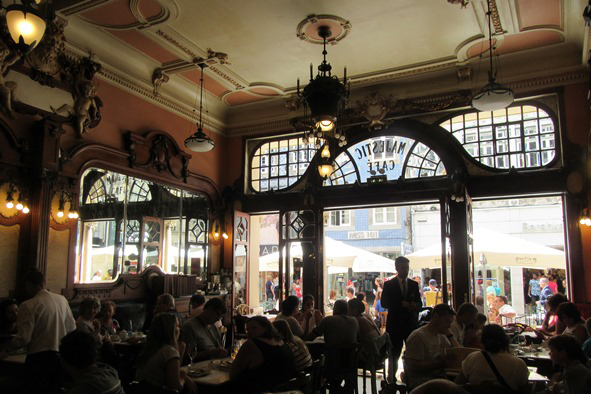
Inside Majestic Cafe (Photo: Mike Dunphy)